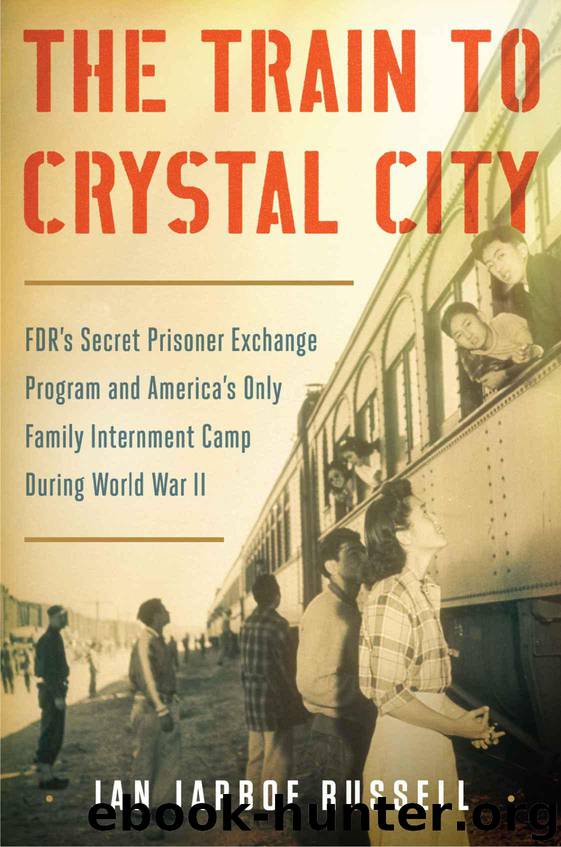The Train to Crystal City: FDR's Secret Prisoner Exchange Program and America's Only Family Internment Camp During World War II by Russell Jan Jarboe

Author:Russell, Jan Jarboe [Russell, Jan Jarboe]
Language: eng
Format: epub, azw3
Publisher: Scribner
Published: 2015-01-19T22:00:00+00:00
CHAPTER THIRTEEN
The False Passports
On the morning of January 20, 1945, while Ingrid was still at sea on the MS Gripsholm, a fourteen-year-old girl, Irene Hasenberg, slept on a narrow wooden shelf in a barrack with three hundred Jews at Bergen-Belsen concentration camp. Irene weighed only seventy-three pounds and was infested with lice. For Irene the worst moment of the day was waking up and wondering if her mother or father was dead. On this day, her father, John, a human skeleton dressed in rags, had already gone to work. In the barrack, Irene and her brother, Werner, wakened her mother, Gertrude, who was so undernourished she had not been out of bed for months, and helped her get dressed.
For the past eleven months, Irene and her family had survived in Bergen-Belsen for only one reason. As “exchange Jews” they were more valuable to the Nazis alive than dead. That morning word came back to the barrack that an exchange transport was imminent. The Germans were expected to deliver 856 Americans for an equal number of Germans.
Now, late in the war, the Allies had won the Battle of the Bulge, and Germany was on its heels. Russian troops had crossed into Germany and at that moment were fifty miles from Berlin. Auschwitz would be liberated by Russian troops seven days later, on January 27. Bergen-Belsen, however, was still crowded with Jews from around the world. Few American citizens were left in Germany, not enough for Germany to make its 856 quota for the trade. On this morning a Kapo, a Jewish prisoner who acted as a trustee, walked into Irene’s barrack and announced that anyone who had any kind of passport other than German might make it out of Bergen-Belsen in the next few days. The Hasenbergs did not have American passports, but they did have falsified passports from Ecuador. As a result, their names were hastily added to the list for this last exchange of the war.
In the massive disruption of World War II neither Irene nor Ingrid knew that each was part of the one-to-one exchange. Though they had no idea of each other’s existence, Ingrid and Irene nonetheless shared other things in common: each had lost her home, school, and friends. They were roughly the same age and looked alike, having blue eyes and being naturally thin as reeds. Irene’s hair was light brown, Ingrid’s brassy red. The exchange was intended as Germans for Americans, but these two teenagers were exceptions: a German Jew in Bergen-Belsen traded for an American in Crystal City. For Irene, the right passport made the difference between life and death, and she would later call it the first miracle of her survival. As for Ingrid, her American birth certificate spared her nothing.
As a victim of the German Holocaust, Irene’s experience was much worse that Ingrid’s internment in Crystal City. However, their exchange was both rooted in internment. Like Crystal City, which housed numerous nationalities and existed in part for exchange, Bergen-Belsen was started
Download
The Train to Crystal City: FDR's Secret Prisoner Exchange Program and America's Only Family Internment Camp During World War II by Russell Jan Jarboe.azw3
This site does not store any files on its server. We only index and link to content provided by other sites. Please contact the content providers to delete copyright contents if any and email us, we'll remove relevant links or contents immediately.
| Afghan & Iraq Wars | American Civil War |
| American Revolution | Vietnam War |
| World War I | World War II |
Waking Up in Heaven: A True Story of Brokenness, Heaven, and Life Again by McVea Crystal & Tresniowski Alex(37013)
Empire of the Sikhs by Patwant Singh(22176)
We're Going to Need More Wine by Gabrielle Union(18081)
Hans Sturm: A Soldier's Odyssey on the Eastern Front by Gordon Williamson(16731)
Leonardo da Vinci by Walter Isaacson(11913)
The Radium Girls by Kate Moore(10914)
Educated by Tara Westover(7073)
Tools of Titans by Timothy Ferriss(6958)
How to Be a Bawse: A Guide to Conquering Life by Lilly Singh(6698)
The Last Black Unicorn by Tiffany Haddish(5078)
Permanent Record by Edward Snowden(5004)
The Rise and Fall of Senator Joe McCarthy by James Cross Giblin(4851)
Promise Me, Dad by Joe Biden(4453)
The Wind in My Hair by Masih Alinejad(4427)
The Crown by Robert Lacey(4111)
A Higher Loyalty: Truth, Lies, and Leadership by James Comey(4038)
The Iron Duke by The Iron Duke(3642)
Joan of Arc by Mary Gordon(3263)
How to be Champion: My Autobiography by Sarah Millican(3191)
